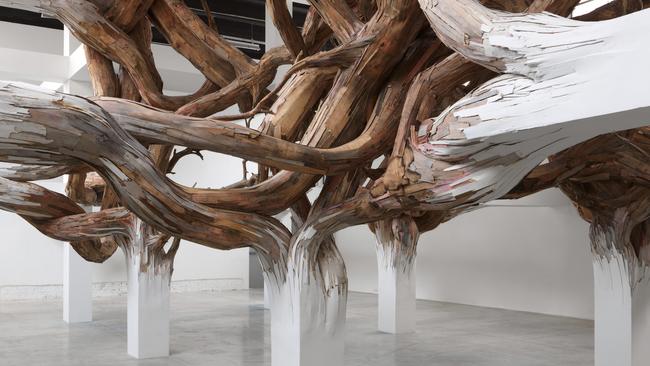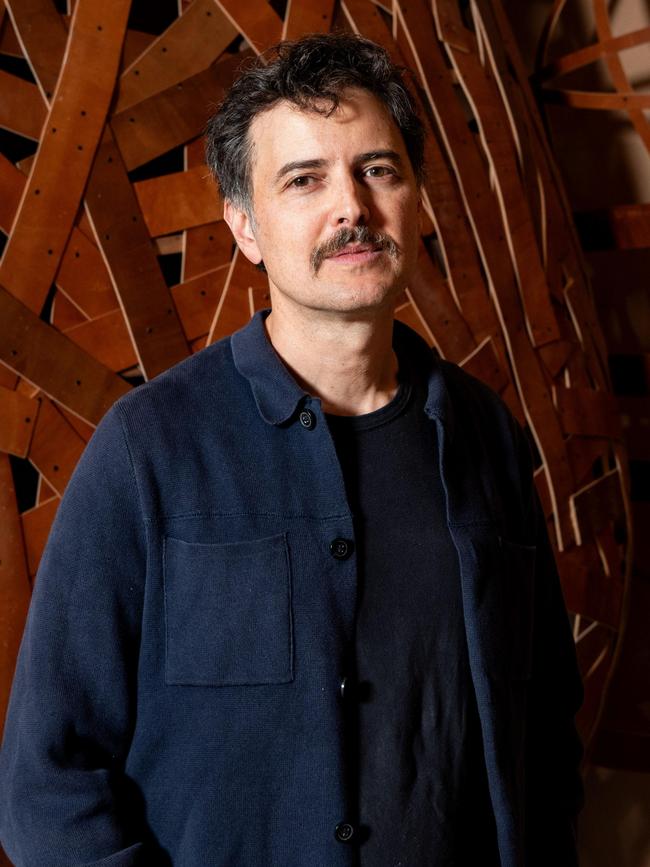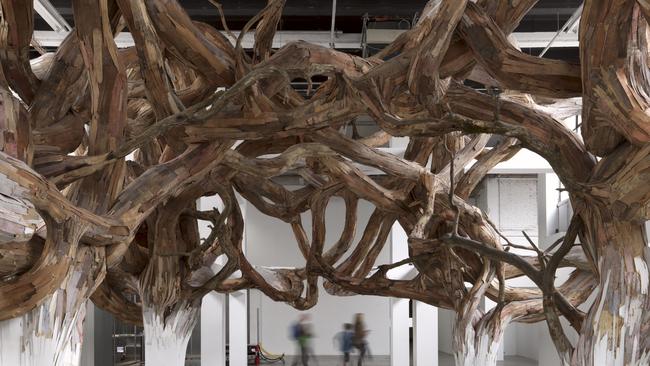How Henrique Oliveira confronted every artist’s worst fear
Brazilian artist Henrique Oliveira evokes the grandeur of the Amazon in his works. But as with tree roots, his career has taken many twists and turns.

Ten years ago Henrique Oliveira was facing every artist’s worst fear. Just days before the opening of his most significant international showing at the Palais de Tokyo in Paris, Europe’s largest contemporary art centre, he was unable to complete the centrepiece of his exhibition because the materials he needed were still tangled up in customs. After spending two months assembling the installation in Paris, the final pieces of wood he needed remained stuck in Brazil where border officials assumed the reclaimed tapumes – a plywood material traditionally found in his home country – were of significant commercial value.
“They didn’t understand this material had just been taken from trash around the streets of Sao Paulo,” Oliveira says. “I thought, ‘Oh, no’. This was supposed to be one of the defining shows of my international career because it was high visibility and the museum had given me the most amazing room.”
Oliveira made a side trip to a forest outside of Normandy to collect extra branches for the installation and at the eleventh hour the materials were released by customs. In the end his exhibition, titled Baitogogo, went ahead and was a huge success.

But the frustration was so debilitating for Oliveira, 50, that he imminently started planning his move to Europe. While much of his work reads as a love letter to Paris – he recently returned from opening a collaborative project held by the Musée du Louvre and global art showcase Paris+ par Art Basel – Oliveira eventually settled in London where he has lived for three years.
The artist is renowned for his large-scale wood installations, which evoke tree trunks sprouting from gallery walls or mangroves suspended from ceilings. In a career spanning the globe he has held fellowships and residencies at renowned institutions such as the Cité Internationale des Arts in Paris and the Smithsonian in Washington DC, and has exhibited in his home city of Brazil – where he still has a studio – in Germany and in Japan.
Oliveira is speaking with Review via video call from his London apartment ahead of his upcoming installation, Corupira, commissioned by Brisbane’s Gallery of Modern Art. Marking the artist’s first visit to Australia, Corupira will act as a portal into the woods of GOMA’s Fairy Tales exhibition, which will also include works by artists such as Yayoi Kusama, Tracey Moffatt and Del Kathryn Barton.
Exhibition curator Amanda Slack-Smith says that Oliveira creates an other-worldly entry to the show, which examines the culture of folk stories.
“It asks you to let go of any preconceived notions before you cross into the next room of classic fairytales,” she says. “The woods is about crossing a threshold into a magical world that you can’t control. As urban dwellers, we don’t get out into these spaces often so there’s a magic that comes with the unknown.”

Corupira is named after a folkloric figure from Brazilian culture whose origins go back to the Indigenous Tupi-Guarani people, who inhabited the Sao Paulo region prior to Portuguese colonisation. As legend has it, Corupira is a kind of demon with backward feet, who exploits the uncharted territory of the forest by baffling travellers with the direction in which he moves. While Oliveira acknowledges there is a childlike wonder to the fairy tales passed down from generation to generation, there’s a mystery in physical spaces, such as the woods, being transformed into sites of unexpected danger.
“We think of fairies and princesses, but fairy tales play with the darkness, the unconscious, the surreal,” he says. “I never think of my work in terms of fairy tales, but the sense of magic is in the transformation of old materials into something that feels like a forest.”
Oliveira uses discarded tapume because it melds into its environment when painted, calling to mind grand images of Amazonian forests.
“The movement of the panels create a discontinuity in the mode we perceive reality because we’re forced away from the white walls of the gallery,” Oliveira explains. “In a matter of seconds you’ve stepped into a completely different world you would otherwise have to travel to by car or train or foot.”
Oliveira, who has never married nor has any children, has been building these new realities into his own life since he was a teenager. Constantly on the move between countries – for school, university, a love of art – he intimately understands the “process of displacement” that he hopes to evoke for audiences.
His nomadic life started when he made the “transformative” move from the town of Ourinhos, which he affectionately translates as “Little Gold”, to Sao Paulo, Brazil’s most populous city. For a 16-year-old who had only known his semirural town, moving cities was an experience akin to travelling through a zone toward possibility.
“There wasn’t any reference to the art world in the town where I grew up,” he says.
“I didn’t know any artists or that art could be a profession. My parents didn’t have any friends who were artists, except maybe amateur Sunday painters.”
Despite the lack of artistic exposure, Oliveira fondly remembers childhood stories about the family’s creative genes.
“My mum would show me pictures from my father’s family,” he says. “Stories of uncles and aunties who were musicians and painters; people who I never met.”
But, as Oliveira explains, it was a psychedelic experience with magic mushrooms at age 18 that truly opened the door to art.
“(Following the hallucinations) I started compulsively trying to draw the experience,” he says, “It opened a gateway to that creativity. I would spend hours drawing on A4 sheets of paper – distorted landscapes, references to fairy tales, the Brazilian countryside. It all began to blur with references to album covers, tattoos, animation.”
By the time he graduated from the University of Sao Paulo with a communications degree, he had amassed a collection of drawings. But his portfolio was useless in kickstarting a career in public relations.
“My parents said, ‘You’re excellent but you should find a day job’ ,” he says with a laugh. “It was from that moment I knew I needed to start studying art seriously.”
Oliveira eventually studied fine arts at the University of Sao Paulo and at age 23 went on to set up his first studio in that city where he blended a love of architecture with surrealist painted wood sculptures.
It quickly became apparent that practising as an international artist in Brazil would be difficult because the art sector was plagued by bureaucratic red tape and export tariffs which made it difficult to enter the European or North American markets.
These days he lives a kind of dual life as an artist making large installations for public-facing commissions in cosmopolitan Europe, while continuing to sell smaller paintings and sculptures in Brazil.
His mother has been a vocal supporter of his career, following him across the globe to shows in Paris and New York. But his father doesn’t leave Brazil.
“In all honesty, I think (my mother) was also fed up with living in a little town,” Oliveira says. “She had a law degree. She was always the one with lots of books, and would read the newspaper every day.
“My dad doesn’t follow the art world, he doesn’t watch films. He only likes to travel to the beach and have a beer,” the artist says with a smile.
When Review asks Oliveira if there’s a long-term plan to make Brazil home again, he responds thoughtfully. “I want to share more of my time between both places, because they are complementary in helping me sustain myself.”
Henrique Oliveira’s Corupira is part of the exhibition Fairy Tales, at QAGOMA, Brisbane, December 2-April 28.

To join the conversation, please log in. Don't have an account? Register
Join the conversation, you are commenting as Logout